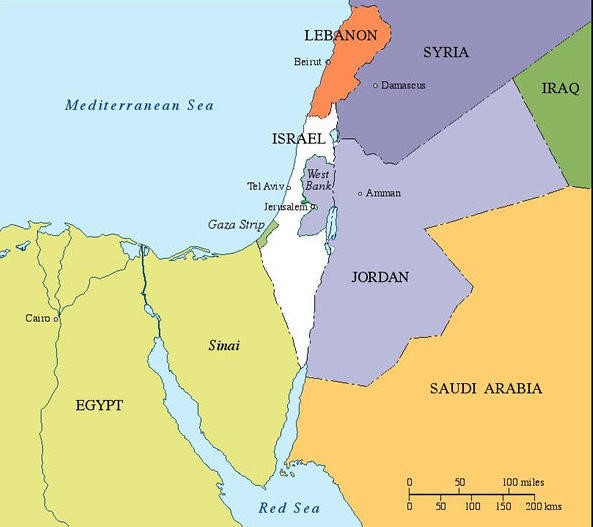
The notion of a two-state solution remains front and center as the most often discussed and endorsed solution to the Palestinian-Israeli dimension of the conflict in the Middle East. So why has it not happened? For a two-state solution to unfold, it must be in the national interests of both Israelis and Palestinians. There must be the will and means to implement the two-state solution. At present, there is neither.
In March 2020, I assembled a set of remarks made by dozens of international organizations and Western world leaders who fervently endorsed a two-state solution to the Israeli-Palestinian conflict, most of them since 2000. In keeping track of similar endorsements for a two-state solution over the last five years, the number of voices, resolutions, and officials from those same origins clamoring for the two-state solution have dramatically increased.
Mixed into the acute demand for the two-state solution are predictions of the dire consequences that will befall primarily to Israel, if Palestinians do not establish a state of their own, and do so now. These fateful predictions include: the eventual end of Israel as a Jewish state, its failure to be democratic and Jewish, and a slow bleeding out of support for Israel from her supporters abroad.
Some say it is already too late for the two-state solution. I disagree.
Researching, writing, and teaching about the conflict for four decades, I understand that the conflict has festered. I can quote chapter and verse of all the proposals made since 1937 to separate the two populations and create two states. Why then is it not too late? History never ends.
Definite disconnects exist between what two-state solution advocates desperately want and what the parties themselves, along with their allies need or are prepared to accept. Why is this?
Political and economic constellations for a two-state solution are not aligned. Arguing over the future of the West Bank and Jerusalem is light years more complex and certainly more emotion-driven than Sadat and Begin quibbling at the end of the 1970s about settlements in Sinai, exchanges of ambassadors, and how much oil Israel would import from Egypt. Once the details were worked out with American help, for Israel, returning Sinai was relatively easy. Sadat knew that he would get Sinai back, and in return receive large amounts of American foreign aid. Both could keep the Soviets away. There were incentives and national interests to make a deal, and one that lasted.
Today, Abbas is no Sadat and Netanyahu is no Begin. To negotiate, implement, and uphold a two-state solution, the political systems must be strong enough to withstand the shocks of inevitable compromise. Both Netanyahu and Abbas oversee divided political communities. Both have political clouds over their heads. More than that.
The Palestinian political community is as divided, dysfunctional, and selfish in governance as it has ever been in its 100-year history. Would you sell or offer a piece of property to a family of a dozen siblings who cannot agree on a fair price, let alone agree on what the property’s dimensions should be? Would you provide land next door to someone who has the intention to have you go away bit by bit? If you are an Israeli decision maker, would you take a chance on establishing a Palestinian state in the regional setting that is being ripped apart by sectarianism and hegemonic groups that totally disrespect the sanctity of borders?
Harp all you want on Kerry/Obama’s call that Jerusalem is occupied territory or Trump’s decision to move the US Embassy to Jerusalem. Castigate Israel all you want for its creeping settlement enterprise as the core reason why negotiations do not unfold.
These points become irrelevant when a robust and strong Palestinian leadership decides precisely what land they do not want west of the Jordan River. And that leadership decides unequivocally that they are willing to end the conflict once and for all without changing Israel’s Jewish majority in a final agreement.
At that point, the first stage is in place to move to a two-state solution for two peoples, side by side. Israel will have to respond, like it had to respond to Sadat’s overture forty years ago. Israeli polling data suggests that its Jewish majority wants a two-state solution. Simultaneously, an equal majority doubts that the Palestinians will do what it takes to initiate such negotiations.
More problematic than Palestinian and Israeli leaders showing a willingness to negotiate earnestly is how might one actually implement a two-state solution?
Unlike Western advocates for a two-state solution, Arab writers and political elites over the last five years have paid minimal attention to the Palestinian quest for statehood, or even Israel for that matter. Palestinian writers habitually berate their own leadership for ineptitude. Most Arab opinion writers are deeply worried about their own states imploding. They say more in their daily writings about the carnage raging in Syria and about Syrians being gassed, displaced, and murdered by their own regime than pundits do in the West. Arab editorials are more concerned about Russian, Iranian, and Turkish imperialism ravaging their homelands than are the two-state solution advocates.
And if and when we find Arab or industrialized countries or organizations willing to provide at least $2.5 billion a year for ten years to nurture a Palestinian state’s economy, then we have lift off.
A trusteeship could be established to implement final status issues on security, Jerusalem, refugees, settlements, borders, refugees and prerogatives of a Palestinian state. Plans and good intentions are noble. Advocates and opponents of a two-state solution must articulate their views.
Yet, without the two parties of the conflict having courage and a willingness to confront their own realities – tachlis – and the funds available to make a two-state solution happen, the advocacy of a two-state solution is only a suggestion or preference. Nothing more, and not now.
